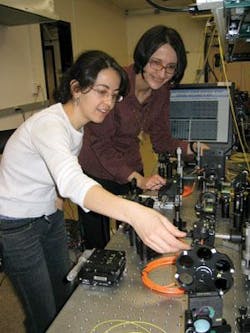PHOTONIC CRYSTALS: Nanocavity lasers may compete with VCSELs

Researchers at Stanford University (Stanford, CA) have published results obtained from photonic-crystal nanocavity laser arrays that may eventually compete with vertical-cavity surface-emitting lasers (VCSELs) for a range of applications including optical telecommunications, optical interconnects, spectroscopic sensing, and optical image processing.1
Photonic-crystal nanocavities can strongly modify the density of optical states, enabling enhancement of the spontaneous emission rate along with the proportion of photons emitted into the lasing mode, thereby reducing the lasing threshold, and significantly improving the achievable direct modulation speed (potentially up to 100 Gbit/s). The drawback of single nanocavities, however, is low output power, on the order of a few nanowatts. Assistant Professor Jelena Vučković and doctoral student Hatice Altug appear to have overcome this problem by packing multiple photonic-crystal nanocavity lasers into 2-D arrays. They obtained single-mode output signals at power levels two orders of magnitude higher than with single-nanocavity lasers. The arrays are thus comparable with VCSEL output powers but operate at lower lasing thresholds.
“A single-mode laser that can be turned on at low ‘pump’ powers, modulated, or turned on and off at high speeds, and that can produce sufficiently high output powers, is crucial for a number of applications,” Vučković said.
The researchers fabricated the lasers in the indium phosphide material system with active regions containing four indium gallium arsenic phosphide quantum wells and a peak photoluminescence emission wavelength of 1560 nm. The optically pumped, 2-D nanocavity laser array consisted of a 9 × 9 square of 81 cavities. The hole radius was varied from 160 to 230 nm to tune the resonant frequency of the nanocavity and the center-to-center distance between holes was 500 nm.
Photonic-crystal nanocavity arrays enable much more precise control of both uniformity and coupling than with VCSELs, according to the researchers, who have demonstrated arrays of 3600 coupled nanocavities. Each cavity occupies an area of only 1.5 µm2, so with ultradense packing about 400,000 lasers could fit on a 1-cm2 chip.
Vučković and Altug have yet to demonstrate that their laser actually modulates faster than a VCSEL. The potential rate of 100 Gbit/s is based on a technique they reported last year for controlling the duration of light pulses emitted from photonic crystals at a rate exceeding 100 Gbit/s. The researchers are also working to boost laser efficiency, convert to electrical pumping, and integrate the device into an electrical computer circuit.
REFERENCE
1. H. Altug and J. Vučković, Optics Express 13(22) 8819 (Oct. 31, 2005).
About the Author
Hassaun A. Jones-Bey
Senior Editor and Freelance Writer
Hassaun A. Jones-Bey was a senior editor and then freelance writer for Laser Focus World.